PORSCHE BOXSTER S 2011 2.G Information Manual
Manufacturer: PORSCHE, Model Year: 2011, Model line: BOXSTER S, Model: PORSCHE BOXSTER S 2011 2.GPages: 66, PDF Size: 11.53 MB
Page 11 of 66

22232223
Independence |
Boxster
Don’t think about taking a step back.
Unless it gives you a better run-up.
B oxs t e r.A roadster is not simply a car. The new
Boxster is not simply a roadster. It ’s a
sports car that brings you closer to the
road, closer to real life and connects
you with your own free spirit.
Its 2.7-litre flat-six engine with direct
fuel injection (DFI) and VarioCam Plus
produces 195 kW (265 hp) at 6,700 rpm
and maximum torque of 280 Nm is available from 4,500 rpm to 6,500 rpm.
The top speed is 164 mph (264 km/ h).
With the precisely geared six-speed
manual gearbox fit ted as standard, the
Boxster accelerates from 0 to 62 mph
(0 to 100 km/ h) in just 5.8 seconds. With
the optional 7-speed Porsche Doppelkup -
plung (PDK) and the optional Sport Chrono
Package including dynamic gearbox
mounts, this time is cut to 5.5 seconds. Power is transmit ted to the road by
18-inch Boxster wheels. Their distinctive
five -spoke design af fords an unobstructed
glimpse of the braking system’s black
four-piston aluminium monobloc fixed
calipers. The optional Porsche Ceramic
Composite Brake (PCCB) provides
motorsport braking performance. The slats on the front air intakes are
painted in the vehicle’s exterior colour.
The sound produced by the central
tailpipe in brushed stainless steel is
unmistakably Porsche.
Lean, muscular and athletic, the car has
inherited motorsport genes. They are characteristic of the Porsche family and
are vital to the irresistible appeal of the
sports car. They are traits that make the
Boxster the sports star among roadsters.
Dynamic performance, whether the hood
is open or closed, has become
synonymous with driving pleasure.
For fuel consumption and CO
2 emissions please refer to page 127.
Page 12 of 66
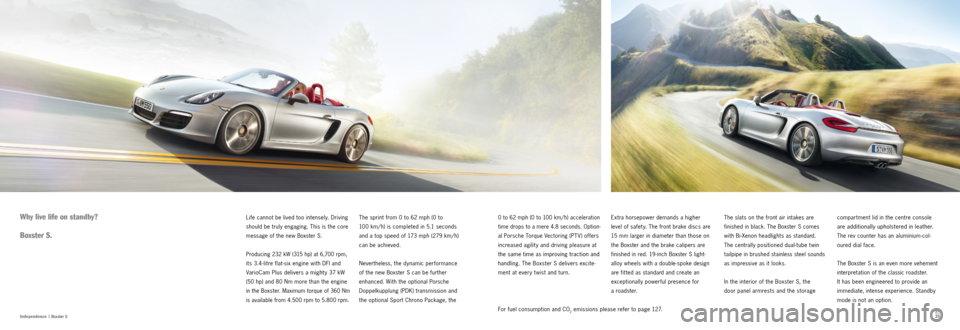
24252425
Independence |
Boxster S
Why live life on standby?
Boxster S.Life cannot be lived too intensely. Driving
should be truly engaging. This is the core
message of the new Boxster S.
Producing 232 kW (315 hp) at 6,700 rpm,
its 3.4-litre flat-six engine with DFI and
VarioCam Plus delivers a might y 37 kW
(50 hp) and 80 Nm more than the engine
in the Boxster. Maximum torque of 360 Nm
is available from 4.500 rpm to 5.800 rpm. The sprint from 0 to 62 mph (0 to
100 km/ h) is completed in 5.1 seconds
and a top speed of 173 mph (279 km/ h)
can be achieved.
Nevertheless, the dynamic per formance
of the new Boxster S can be further
enhanced. With the optional Porsche
Doppelkupplung (PDK) transmission and
the optional Sport Chrono Package, the
0 to 62 mph (0 to 100 km/ h) acceleration
time drops to a mere 4.8 seconds. Option -
al
Porsche Torque Vectoring (PT V) offers
increased agilit y and driving pleas
ure at
the same time as improving traction and
handling. The Boxster S delivers excite -
ment at every t wist and turn. Extra horsepower demands a higher
level of safet y. The front brake discs are
15 mm larger in diameter than those on
the Boxster and the brake calipers are
finished in red. 19-inch Boxster S light-
alloy wheels with a double-spoke design
are fit ted as standard and create an
exceptionally powerful presence for
a roadster. The slats on the front air intakes are
finished in black. The Boxster S comes
with Bi-Xenon headlights as standard.
The centrally positioned dual-tube twin
tailpipe in brushed stainless steel sounds
as impressive as it looks.
In the interior of the Boxster S, the
door panel armrests and the storage
For fuel consumption and CO
2 emissions please refer to page 127. compartment lid in the centre console
are additionally upholstered in leather.
The rev counter has an aluminium-col -
oured dial face
.
The Boxster S is an even more vehement
interpretation of the classic roadster.
It has been engineered to provide an
immediate, intense experience. Standby
mode is not an option.
Page 13 of 66
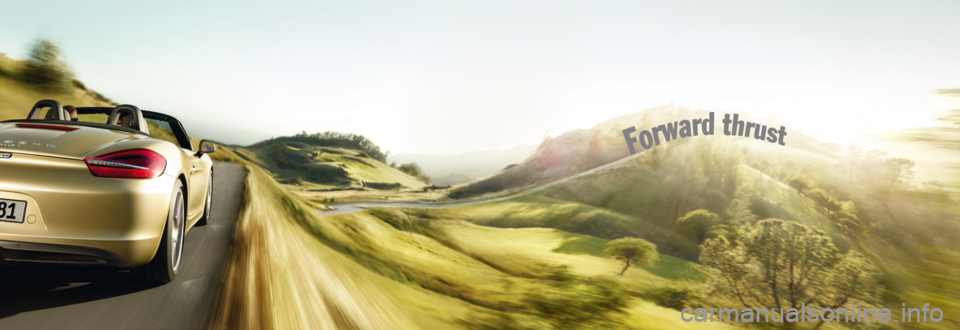
Page 14 of 66
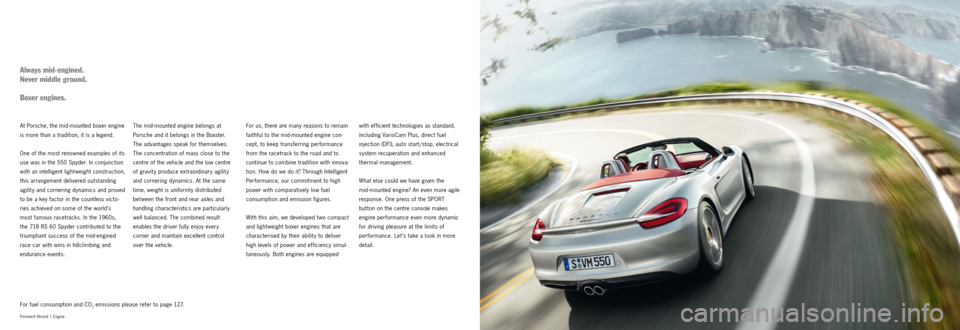
For ward thrust |
Engine
At Porsche, the mid-mounted boxer engine
is more than a tradition, it is a legend.
One of the most renowned examples of its
use was in the 550 Spyder. In conjunction
with an intelligent lightweight construction,
this arrangement delivered outstanding
agility and cornering dynamics and proved
to be a key factor in the countless victo -
ries achieved on some of the world’s
most famous racetracks. In the 1960s,
the 718 RS 60 Spyder contributed to the
triumphant success of the mid-engined
race car with wins in hillclimbing and
endurance events. The mid-mounted engine belongs at
Porsche and it belongs in the Boxster.
The advantages speak for themselves.
The concentration of mass close to the
centre of the vehicle and the low centre
of gravit y produce extraordinary agilit y
and cornering dynamics. At the same
time, weight is uniformly distributed
bet ween the front and rear axles and
handling characteristics are particularly
well balanced. The combined result
enables the driver fully enjoy every
corner and maintain excellent control
over the vehicle.
Always mid- engined.
Never middle ground.
Boxer engines.
For us, there are many reasons to remain
faithful to the mid-mounted engine con -
cept, to keep transferring performance
from the racetrack to the road and to
continue to combine tradition with innova -
tion. How do we do it? Through Intelligent
Performance, our commitment to high
power with comparatively low fuel
consumption and emission figures.
With this aim, we developed t wo compact
and light weight boxer engines that are
characterised by their ability to deliver
high levels of power and efficiency simul -
taneously. Both engines are equipped
For fuel consumption and CO
2 emissions please refer to page 127. with ef ficient technologies as standard,
including VarioCam Plus, direct fuel
injection (DFI), auto start/stop, electrical
system recuperation and enhanced
thermal management.
What else could we have given the
mid-mounted engine? An even more agile
response. One press of the SPORT
but ton on the centre console makes
engine performance even more dynamic
for driving pleasure at the limits of
performance. Let ’s take a look in more
detail.
Page 15 of 66

4
3
1
2
30
313031
For ward thrust |
Engine
2.7-litre engine.
The Boxster is equipped with a 2.7-litre
flat-six engine with direct fuel injection
(DFI) and VarioCam Plus. It generates
195 kW (265 hp) at 6,700 rpm. The
maximum torque of 280 Nm is available
over a broad engine speed range from
4,500 rpm to 6,500 rpm. The new Boxster with six-speed
manual gearbox accelerates from 0 to
62 mph (0 to 100 km/ h) in 5.8 seconds
and reaches a top speed of 164 mph
(264 km/ h). With the optional Porsche
Doppelkupplung (PDK), it completes
the 0 to 62 mph (0 to 100 km/ h) sprint
in 5.7 seconds and achieves a maxi mum
speed of 162 mph (262 km/ h). In conjunc -
tion
with PDK the optional Sport Chrono
Package, the sprint time is reduced to
just 5.5 seconds.
3.4-litre engine.
The Boxster S is powered by a 3.4-litre
flat-six engine with direct fuel injection
(DFI) and VarioCam Plus. It develops
232 kW (315 hp) at 6,700 rpm and the
maximum torque of 360 Nm is produced
bet ween 4,500 rpm to 5,800 rpm.
The new Boxster S with six-speed
manual gearbox races from 0 to 62 mph
(0 to 100 km/ h) in 5.1 seconds and reach -
es a top speed of 173 mph (279 km/ h).
With optional PDK, an acceleration time
of 5.0 seconds and a maximum speed
of 172 mph (277 km/ h) are achieved.
For fuel consumption and CO
2 emissions please refer to page 127. In conjunction with the optional Sport
Chrono Package, the Boxster S with PDK
finishes the sprint in only 4.8 seconds.
1 Power output and torque chart for the Boxster
2 Power output and torque chart for the Boxster S
3
Engine, gearbox and exhaust system of the Boxster S
4 Boxster S engine
40 60 80
100 120 140 160 180 200
220 240 260
1500 75008000
2000 2500300035004000450050005500600065007000
1000
280
Power (kW)
T orque (Nm)
Engine speed (rpm)
200
280 300 320 340 360 380 400 420
220 240 260
440
195 kW (265 hp)
280 Nm
40
60 80
100 120 140 160 180 200
220 240 260
1500 75008000
2000 2500300035004000450050005500600065007000
1000
280
Power (kW)
T orque (Nm)
Engine speed (rpm)
200
280 300 320 340 360 380 400 420
220 240 260
440
232 kW (315 hp)
360 Nm
Page 16 of 66

32333233
Resonance intake manifold.
The resonance effect, where the air
mass inside the intake manifold is
caused to oscillate is used to optimise
the induction process at all engine
speeds. The engine in the Boxster S is
additionally equipped with a switchable
resonance valve.
The results are high torque, a flat ter
torque curve and high power output.
The sound produced is characteristically
resonant and deep, as you would expect
of a Boxster.
Direct fuel injection (DFI).
Direct fuel injection (DFI) is featured
as standard in both Boxster models.
Multi-hole injectors deliver fuel directly
into the combustion chamber with milli -
second precision. The injection pattern
has been optimised for torque, power
output, fuel consumption and emissions.
With direct injection, the engine manage -
ment system regulates injection timing
individually for each cylinder, as well as
the injection rate for each cylinder bank.
This optimises the combustion process
and therefore fuel economy. Depending
on the engine operating conditions, multi -
ple fuel injections can take place on each operating cycle. This allows the cata
-
ly tic converter to reach normal operating
temperate sooner after a cold start and a
higher maximum torque to be achieved.
DFI improves the internal cooling of the
combustion chamber by having the
mixture prepared directly in the cylinder.
This allows for a higher compression ratio,
which helps to deliver higher power output
at the same time as enhanced engine
efficiency. Injection is regulated by the
electronic engine management system
and emissions are monitored by the stereo
Lambda sensors.
For fuel consumption and CO
2 emissions please refer to page 127.
Page 17 of 66
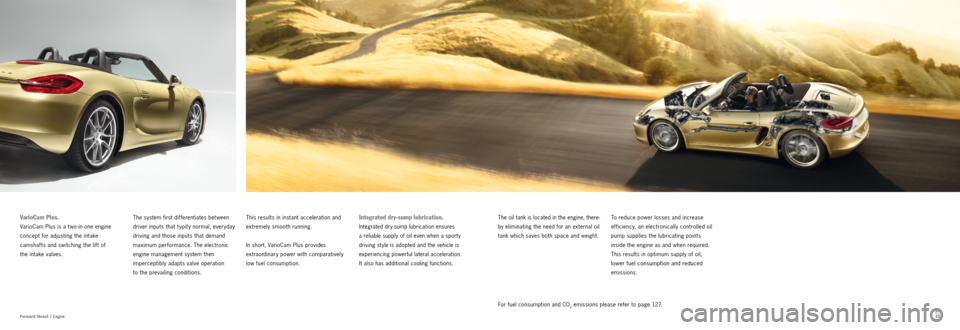
3435
VarioCam Plus.
VarioCam Plus is a two-in-one engine
concept for adjusting the intake
camshafts and switching the lift of
the intake valves. The system first dif ferentiates bet ween
driver inputs that typify normal, everyday
driving and those inputs that demand
maximum performance. The electronic
engine management system then
imperceptibly adapts valve operation
to the prevailing conditions. This results in instant acceleration and
extremely smooth running.
In short, VarioCam Plus provides
extraordinary power with comparatively
low fuel consumption.
Integrated dry-sump lubrication.
Integrated dr y-sump lubrication ensures
a reliable supply of oil even when a sport y
driving st yle is adopted and the vehicle is
experiencing powerful lateral acceleration.
It also has additional cooling functions. The oil tank is located in the engine, there
-
by eliminating the need for an external oil
tank which saves both space and weight.
To reduce power losses and increase
efficiency, an electronically controlled oil
pump supplies the lubricating points
inside the engine as and when required.
This results in optimum supply of oil,
lower fuel consumption and reduced
emissions.
For ward thrust |
Engine
For fuel consumption and CO2 emissions please refer to page 127.
Page 18 of 66
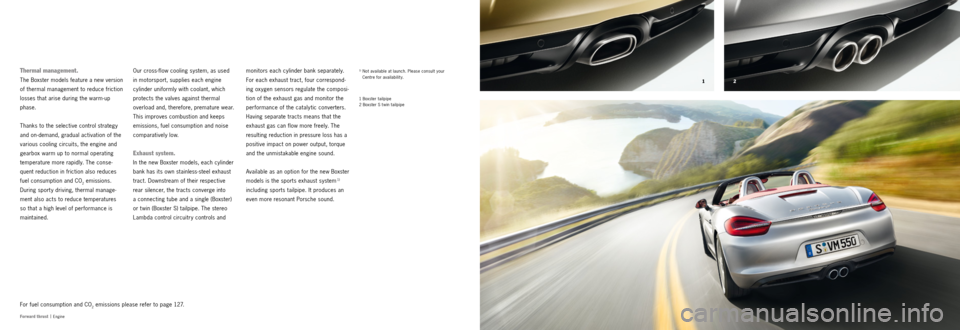
12
Thermal management.
The Boxster models feature a new version
of thermal management to reduce friction
losses that arise during the warm-up
phase.
Thanks to the selective control strategy
and on-demand, gradual activation of the
various cooling circuits, the engine and
gearbox warm up to normal operating
temperature more rapidly. The conse -
quent reduction in friction also reduces
fuel consumption and CO
2 em issio ns.
During sporty driving, thermal manage -
ment also acts to reduce temperatures
so that a high level of performance is
maintained. Our cross-flow cooling system, as used
in motorsport, supplies each engine
cylinder uniformly with coolant, which
protects the valves against thermal
overload and, therefore, premature wear.
This improves combustion and keeps
emissions, fuel consumption and noise
comparatively low.
Exhaust system.
In the new Boxster models, each cylinder
bank has its own stainless-steel exhaust
tract. Downstream of their respective
rear silencer, the tracts converge into
a connecting tube and a single (Boxster)
or t win (Boxster S) tailpipe. The stereo
Lambda control circuitr y controls and monitors each cylinder bank separately.
For each exhaust tract, four correspond
-
ing oxygen sensors regulate the composi -
tion of the exhaust gas and monitor the
performance of the catalytic converters.
Having separate tracts means that the
exhaust gas can flow more freely. The
resulting reduction in pressure loss has a
positive impact on power output, torque
and the unmistakable engine sound.
Available as an option for the new Boxster
models is the sports exhaust system
1)
including sports tailpipe. It produces an
even more resonant Porsche sound.
For ward thrust |
Engine
For fuel consumption and CO2 emissions please refer to page 127.
1) Not available at launch. Please consult your
Centre for availability.
1 Boxster tailpipe
2 Boxster S t win tailpipe
Page 19 of 66
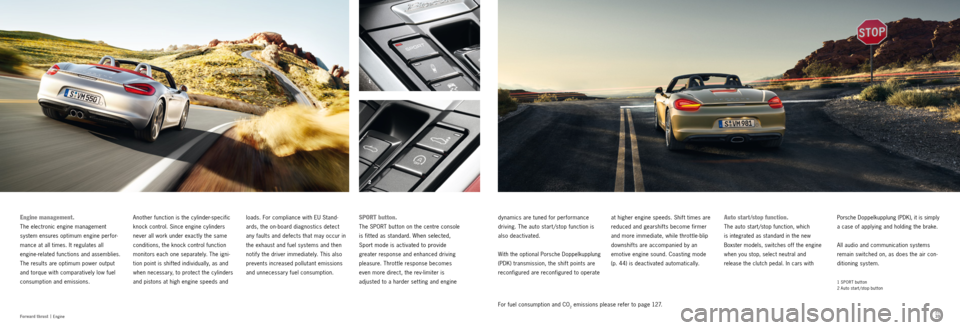
1
2
38 39
Engine management.
The electronic engine management
system ensures optimum engine perfor -
mance at all times. It regulates all
engine-related functions and assemblies.
The results are optimum power output
and torque with comparatively low fuel
consumption and emissions. Another function is the cylinder-specific
knock control. Since engine cylinders
never all work under exactly the same
conditions, the knock control function
monitors each one separately. The igni
-
tion point is shifted individually, as and
when necessary, to protect the cylinders
and pistons at high engine speeds and loads. For compliance with EU Stand
-
ards, the on-board diagnostics detect
any faults and defects that may occur in
the exhaust and fuel systems and then
notify the driver immediately. This also
prevents increased pollutant emissions
and unnecessary fuel consumption.
SPORT button.
The SPORT but ton on the centre console
is fit ted as standard. When selected,
Sport mode is activated to provide
greater response and enhanced driving
pleasure. Throttle response becomes
even more direct, the rev-limiter is
adjusted to a harder set ting and engine dynamics are tuned for performance
driving. The auto start/stop function is
also deactivated. With the optional Porsche Doppelkupplung
(PDK) transmission, the shift points are
reconfigured are reconfigured to operate at higher engine speeds. Shift times are
reduced and gearshifts become firmer
and more immediate, while throttle-blip
downshifts are accompanied by an
emotive engine sound. Coasting mode
(p. 44) is deactivated automatically.
Auto start/stop function.
The auto start/stop function, which
is integrated as standard in the new
Boxster models, switches of f the engine
when you stop, select neutral and
release the clutch pedal. In cars with
For ward thrust |
Engine
For fuel consumption and CO2 emissions please refer to page 127.
Porsche Doppelkupplung (PDK), it is simply
a case of applying and holding the brake.
All audio and communication systems
remain switched on, as does the air con -
ditioning system.
1 SPORT button
2 Auto start /stop but ton
Page 20 of 66
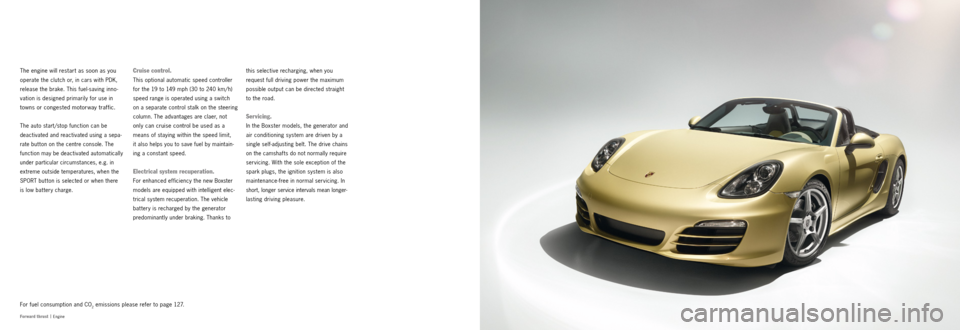
For ward thrust |
Engine
For fuel consumption and CO2 emissions please refer to page 127.
The engine will restart as soon as you
operate the clutch or, in cars with PDK,
release the brake. This fuel-saving inno -
vation is designed primarily for use in
towns or congested motorway traffic.
The auto start /stop function can be
deactivated and reactivated using a sepa -
rate but ton on the centre console. The
function may be deactivated automatically
under particular circumstances, e.g. in
extreme outside temperatures, when the
SPORT but ton is selected or when there
is low bat tery charge.
Cruise control.
This optional automatic speed controller
for the 19 to 149 mph (30 to 240 km/ h)
speed range is operated using a switch
on a separate control stalk on the steering
column. The advantages are claer, not
only can cruise control be used as a
means of staying within the speed limit,
it also helps you to save fuel by maintain -
ing a constant speed.
Electrical system recuperation.
For enhanced efficiency the new Boxster
models are equipped with intelligent elec-
trical system recuperation. The vehicle
bat tery is recharged by the generator
predominantly under braking. Thanks to this selective recharging, when you
request full driving power the maximum
possible output can be directed straight
to the road.
Servicing.
In the Boxster models, the generator and
air conditioning system are driven by a
single self-adjusting belt. The drive chains
on the camshafts do not normally require
servicing. With the sole exception of the
spark plugs, the ignition system is also
maintenance-free in normal servicing. In
short, longer service intervals mean longer-
lasting driving pleasure.